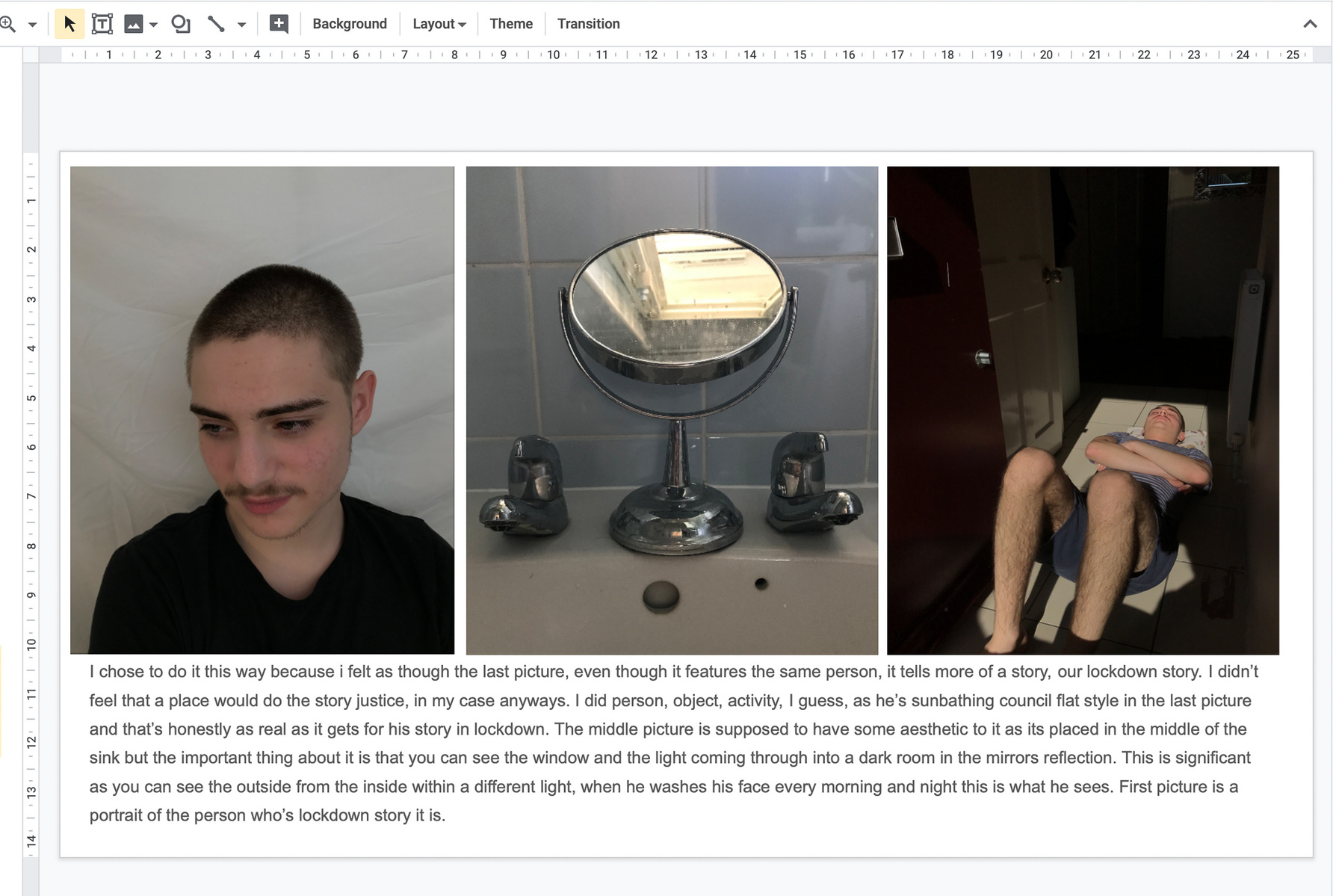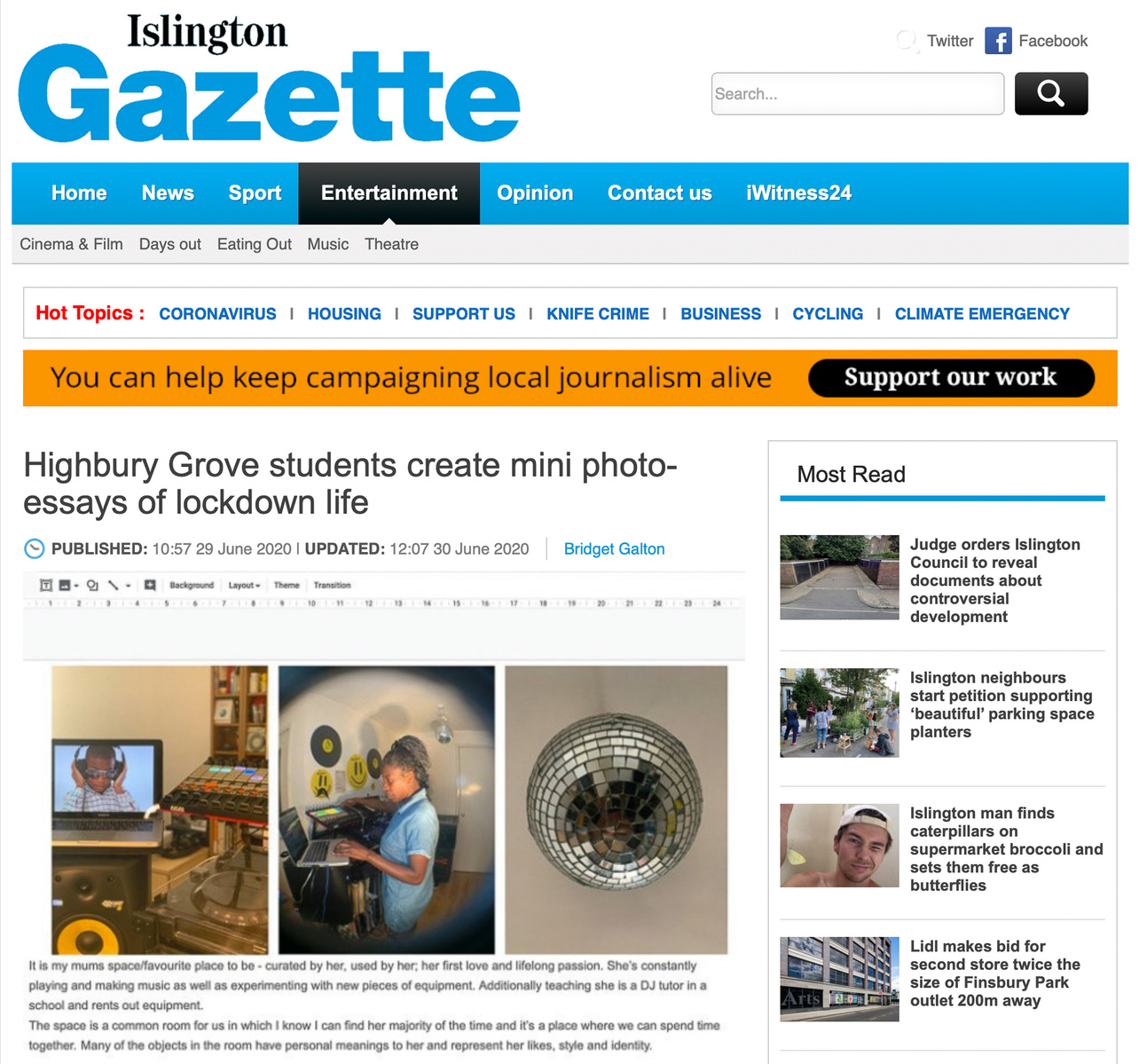Lockdown Creativity
Creativity for me is a hands on, personally engaged process and a throughly collaborative experience. A few months ago, my creative process was forced to change - luckily, adapting to work life during lockdown provided me with a hugely positive and enjoyable venture, which concluded in the most unexpected and rewarding way.
Here in the UK, March 23rd 2020 signalled the beginning of lockdown to curtail the spread of SARS-CoV-2. Finally following many of our mainland European neighbours into a necessitated new reality, the nation’s work life had to radically adjust to cope with COVID-19’s viral demands. Non-essential travel and employment was rightly put on hold, and along with much of the creative industries, photographers like myself had to seek alternate avenues of communicating our skillset.
Fortunately for me, lockdown provided a totally unexpected, yet optimistic opportunity - a move online via webinars. Like the distinct lack of steel birds overhead, near zero road traffic noise and a general ‘calm’ in the nature, I embraced my new online persona by producing a 6 part series of photography education webinars in collaboration with the City of London Academy Highbury Grove School, commissioned by Culture Mile to extend the reach of The Hidden City.
Shot during December 2019 and January 2020, The Hidden City is a photographic series of 18 triptychs aiming to change perceptions of the City of London and showcase the everyday creativity that takes place behind the scenes, across the City. My objective was to distill each of the 18 featured organisations into one triptych containing an illustrative object, a sense of place and a person or persons who embodies the spirit of the organisations’ purpose.
The resulting series has been warmly received and ambitious plans were drawn to display in the work in a grand printed exhibition in the Great Hall in the grounds of London’s St Bartholomew Hospital and additional outdoor representation during the summer of 2020. Plans were also afoot to present the work as part of London Careers Festival in late June. With the advent of lockdown these plans were postponed or cancelled, and like the rest of the creative sector, a huge transition to digital delivery proceeded.
In early April Beth Crosland, the Senior Programme Manager (Culture Mile Learning) reached out to me with an idea she and Ella James, Deputy Subject Leader of Art (City of London Academy Highbury Grove School) of putting together a formal education module aimed at coaching A Level & BTEC students (in the UK - ages 16 to 18 years) through their own lockdown schooling. I jumped at the chance - not only to satisfy my own social responsibility and moral compass but also to further extend the reach of The Hidden City.
Key project aims within the education module:
To deliver a detailed analysis of the characteristics of shooting on location in collaboration with Emile Holba, and his recent work, Hidden City. Students will be guided to respond to a ‘client brief’ through webinars delivered by the artist and art teacher, Ella James. These sessions will break down the essential stages to overcoming the challenges faced when taking professional quality photographs outside of a studio.
Key student outcomes:
1) To develop an understanding of the different techniques used in industry to create a quality image.
2) To apply the theory of professional equipment to everyday items in the home.
3) To generate contact sheets that documents a site visit.
4) To present a portfolio of photographs that respond to a brief.
With the framework decided, we moved forward rapidly into realising the goals via Zoom - the video conferencing platform of the moment.
(the video clip below features a typical start to our webinars)
Each 45 minute webinar had its own focus within the series’s narrative arc. We planned 5 episodes and ultimately produced 6, as the narrative flow and student response was so rich.
To ensure Ella and I had the best possible chance of student engagement from the start, we acted on two key decisions. The first was that I suggested that we embraced video calling’s dual screening to create a more conversational feel to the lessons. This allowed for Ella (the teacher) not only to subtly steer each session, mindful of education’s official structural requirements, but also to serve as a familiar visual reference - as the students regular teacher in the video frame along side myself, the guest imparting knowledge and work experience.
The second was for a more interactive feel to the webinars, whereby Ella and I would set a daily task related to the what we had discussed in the episode and requested task compulsion prior to recording the next episode - this allowed episodes 2 to 6 to start with a mini review / progress check of the students’ work before embarked on the episode specific content.
Upon reflection - these two decisions, were, we think, key to the webinars’ overwhelming success. During those heady days of lockdown, we also decided to compress the episodes into a period of 10 days, which ensured a degree of intensity and urgency. Again, a healthy decision.
(the slides below features 4 screen grabs illustrating a taster of the set-up from the webinars - including 2 pupil submitted slides detailing their working process after learning how to modify light via our ‘Minted to Skinted’ tutorial).
It is worth noting that producing the webinars in this manner allowed for sound compliance around safeguarding. All webinars were uploaded to a non-public, password protected Vimeo channel and work submitted by the students to a secure Google Classroom folder was reviewed and then anonymised for inclusion in the subsequent webinar.
As Ella and I embarked on making the series, we agreed that preparation was essential both in terms of continuity and consistency of message but also in terms of that seemingly improvised conversational flow. So each day we would spend up to two hours scripting, sorting subject / theme order and making notes whilst reviewing students’ work. This planning worked a treat, as each webinar is recorded in one take, with no edits. Who knew that lockdown would turn me temporarily into a millennial vlogger :-)
Ultimately, all that preparation and passion to communicate essential creative skills during lockdown would only succeed if the students were receptive and engaged. To our delight, they were and many produced an exceedingly high standard of work. Not only did they embrace the concept of interpreting a creative brief but also readily absorbed all the tips and tuition required to produce a noteworthy triptych. Over the course of 5 episodes, the students learnt the following skills:
1) Perception of space.
2) The weight of an object.
3) The temporary team.
4) Light source and light modification.
5) Hard and soft lighting.
6) Natural vs staged.
7) Micro and macro.
8) Body language and costume.
9) Creating a narrative.
10) Refining the edit.
(the following slide shows one of the student’s creative process, which I believe is nearly as important as the final vision.)
The work submitted was so strong, Ella and I decided to record a 6th episode containing more in-depth feedback.
The following slides feature the final work from some of the students, who have all given their permission to be highlighted within this Journal entry. The work is screen-grabbed from the Google Classroom slides, with each student crafting defined triptychs clearly displaying an object, person and space.
I’m sure you’ll agree, the all the final submissions provide excellent insight and creativity (click any to view large).
The whole process and outcome was extremely rewarding for me personally, as it was incredible to witness each student’s progress throughout the recording of the webinars. Each student reacted to the webinars’ content and instruction and the feedback has been very positive too, especially during the strange haze produced by lockdown.
I shall conclude with some feedback from one student’s parent, who explained that her child had been suffering from depression and low motivation during lockdown. The parent continued to say that the webinars provided an unexpected lifeline, as their child not only got out of bed, but said that the creative process was worth getting up for. An extraordinary outcome during an extraordinary period of time, and I couldn’t have smiled more to know that Ella and I’s work had been such an inspiration.
[Update: a wonderful response from Ella]
“Working with Emile has been such a huge insight into the working processes of an artist. Through our collaboration, we learnt how to translate the creative process in location photography into a workable series of tasks. Whilst filming, it became apparent that photography has historically had too much emphasis on the camera, rather than the core principles of composition and lighting. Emile’s rich experience allowed us to reimagine studio lighting, working with a team and taking a portrait into something that can be done by anyone at home. I leave this experience having seen how to use photography as a tool to examine and explore our immediate surroundings. I am excited to interweave the Hidden City into next year, knowing the immensely positive impact a course such as this has on student outcomes.”
I wish to extend my warmest thanks to Beth for seeing the potential of developing this educational module during a time of much uncertainty and, of course, introducing myself to Ella with whom I’ve thoroughly enjoyed creating some online magic with. Finally, thank you to the wider Culture Mile team for generously supporting the production of these webinars and the expanding The Hidden City ecosystem.
[Update: Islington Gazette have featured the series]
The journalist Bridget Galton has written a great article highlighting the webinar series’s success. You can read it over at the Islington Gazette.
If you would like to discover more of The Hidden City triptychs that inspired these education webinars, then take a look at Culture Mile’s mini site called The Hidden City - Culture Mile and also my own gallery - enjoy!







